First drive: Hyundai Ioniq
The Ioniq launches a three-pronged eco-attack on the Prius and Leaf - and looks to have the measure of its competitors.
Hyundai is looking to cover all its eco bases in one go with the new Ioniq, which is the first car to be offered with hybrid, plug-in hybrid and full EV powertrains. With such variety, Hyundai is aiming at a variety of cars, namely the Toyota Prius and Nissan Leaf.

Crucially, Hyundai has pitched the pricing of its three-pronged model well below these rivals, so a top spec Ioniq costs much the same as the entry-point cars from Toyota and Nissan. With only the Hybrid currently available for lease, we might have to wait a short while to see how leasing rates work out for the Hyundai Electric, but it’s clear the Korean firm is taking the fight straight to the competition. This includes a five-year unlimited mileage warranty for the car and eight-year, 125,000-mile cover for the battery.

How many trims are there for the Ioniq Hybrid?
To give you an idea of the value the Ioniq offers, the range kicks off with the £19,995 SE 1.6 GDi Hybrid. For that, you get alloy wheels, cruise control, rear parking sensors with camera, and DAB digital radio. Every Ioniq also comes with autonomous emergency braking, Lane Keep Assist System and tyre pressure monitoring, so it’s far from a stripped out economy model.
Upgrade to the Premium version for £21,795 and you get all sorts of extra goodies that encompass sat-nav with 7in LCD screen, Android Auto and Apple CarPlay, and wireless charging for suitable mobile phones. Then the Premium SE ups the ante at £23,595 with leather upholstery, Blind Spot Detection and Front Park Assist.
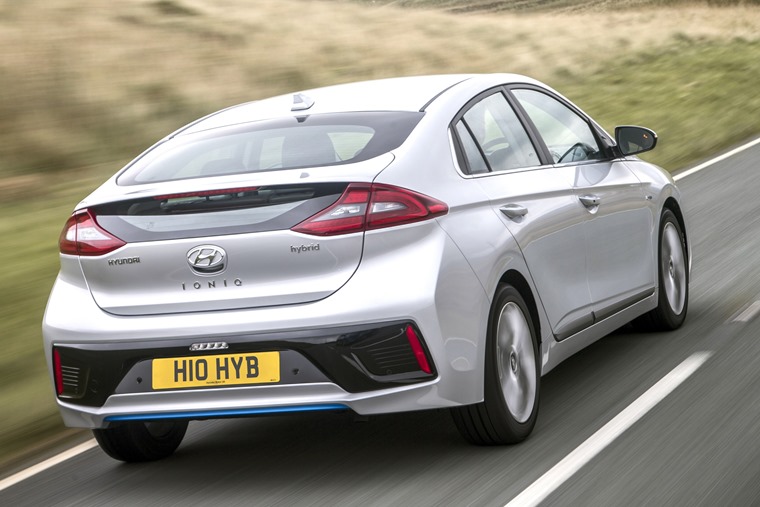
As for the Ioniq Electric, that is powered solely by battery power and kicks off at £24,495 for the Premium and rises to £26,295 for the Premium SE. The Hybrid Plug-In version will arrive later in 2017.
So much for the value proposition, is the Ioniq any good? If you’re coming to the Hyundai from a Toyota Prius, the news is resoundingly good. Not only is the Korean cheaper and better kitted out, it’s also of a higher quality on the inside. There are still some hard plastic finishes inside the Ioniq, but it all feels better put together and more substantial than the Prius.
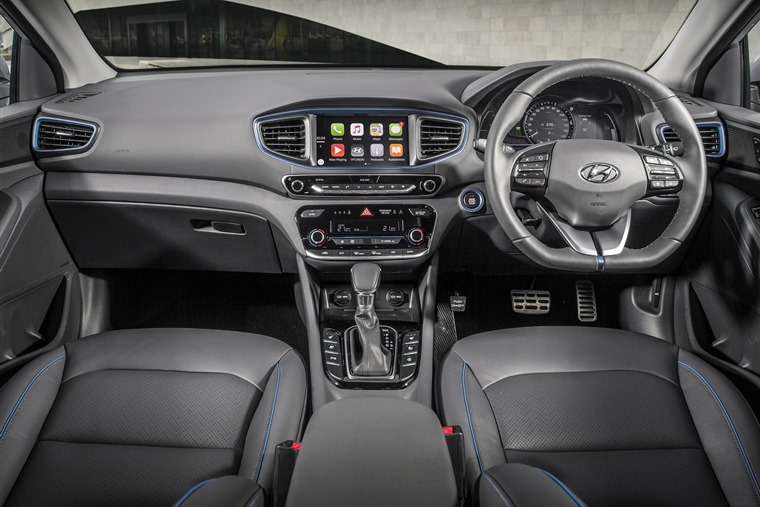
Are the engines the only thing different about the Ioniq range?
There are subtle differences between the Hybrid and Electric versions of the Ioniq on the inside too. The centre console is the obvious one, where the petrol-electric car has a traditional set-up with automatic transmission lever in the middle. For the EV, there’s no gear stick, just buttons to select Drive, Reverse and Park. This is easy to get used to and the EV feels brisker off the mark than the Hybrid thanks to its instant torque, even if the figures say the EV is slower from 0-62mph at 11.5 seconds to the Hybrid’s 11.1 second sprint.
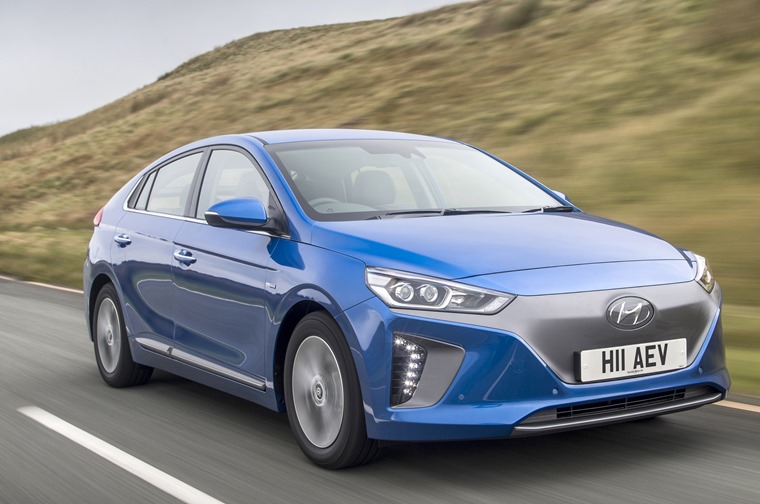
What’s the range of the Hyundai Ioniq Electric?
On the move, the EVs silent progress is soothingly welcome. We wish we could say the same of the ride on more dotted surfaces as the extra weight of the battery and firmer suspension set-up to cope with this means it can become unsettled. The Hybrid is better in this respect, but it’s still some way off being as good as Hyundai’s i30 small hatch.
It’s the same story when it comes to the handling. Low rolling resistance tyres help keep emissions down, but they do little for traction in tighter or more slippery corners. More of a demerit for us, though, is the dull-witted steering. There simply isn’t enough feel in either version of the Ioniq we’ve driven to inspire much confidence or enthusiasm for this car’s dynamics.
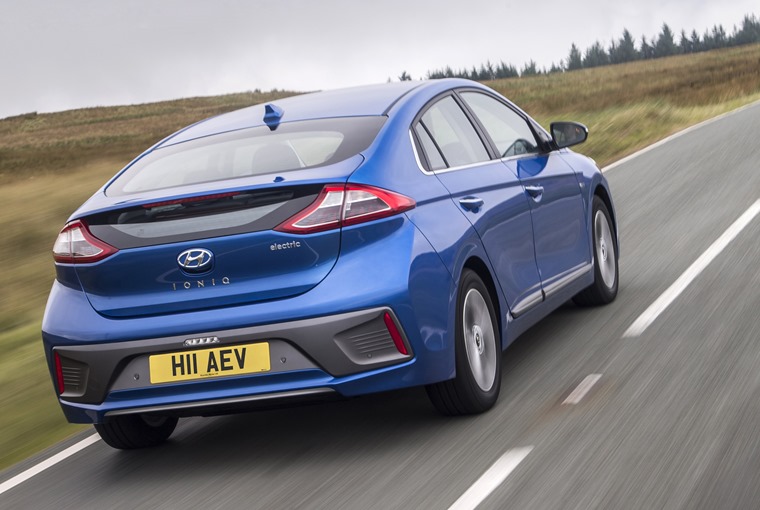
On the plus side, the EV has three stages of brake regeneration, ranging from mild to quite forceful. They can be selected using buttons on the steering wheel and, as such, provide a form of gearing as you approach a corner to slow the car as you would with a downshift with an internal combustion engine. Even better, this helps top up the battery charge and saves on brake wear.
It probably isn’t the best way to use the Ioniq if you want to eke out the claimed 174-mile battery range. During our drive on a dry, sunny day, the range read 112 miles when we set out with a full charge, which seems more realistic and is enough for most daily commutes.
How does the Ioniq Hybrid compare?
Swap into the Hybrid and it offers 70.6mpg combined economy and 92g/km carbon dioxide emissions. Those numbers trail the Toyota Prius by some margin, but we’d be willing to trade for the Hyundai’s lower price, better equipment and greater driver involvement.
The Hyundai’s hybrid system doesn’t allow for electric-only driving on demand and, although it can set off in silent EV mode, the 105hp 1.6-litre petrol motor comes into play as soon as the speed stray above 10mph. That means the petrol engine is working most of the time, though active front air flaps stay closed to help the engine warm up as quickly as possible. After that, they vary when they’re open according to need. You’ll be able to differentiate the Hybrid from the EV Ioniq by front grille as the electric-only model has a completely smooth front end to maximise aerodynamic efficiency.
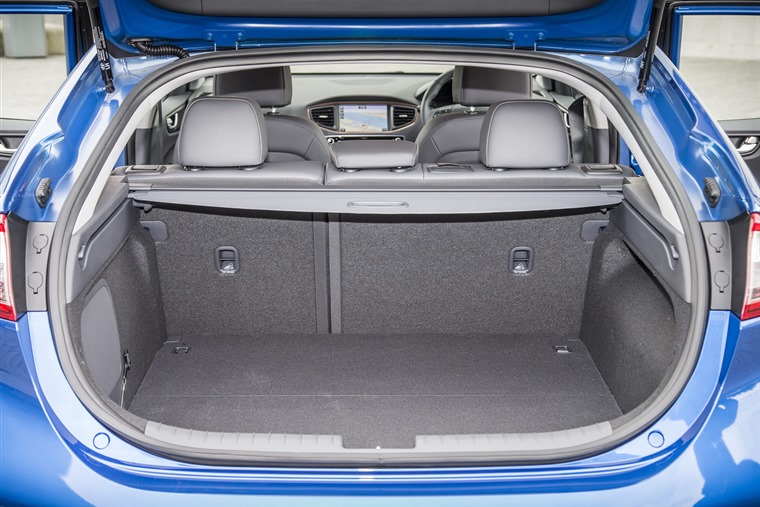
Another way to tell the two apart is to sit in the rear seat. The Hybrid offers more headroom because the EV’s battery pack resides under the seat base and forces the bench to be placed higher. Look in the boot and the EV’s battery also pinches 93-litres of load capacity compared to the Hybrid’s, though it’s still decent at 350-litres. The Hybrid’s 443-litre load bay is big but quite shallow, so larger cases will need to be laid on their side.
That’s not a deal breaker for a car that offers all of the usual benefits of a hybrid or EV car at keen prices. Next to direct rivals, the Hyundai is the one to go for, but this comes with the caveat that a similarly sized diesel-fuelled rival will be more suited to anyone who regularly drives long distances. For those more concerned with short hops and town use, the Ioniq has the measure of its competitors.
Model Tested: | Hyundai Ioniq Hybrid | Hyundai Ioniq Electric |
| List price: | £23,595 | £30,795 |
| Top speed: | 115mph | 103mph |
| 0-62mph: | 10.8secs | 9.9secs |
| Official fuel economy: | 74.3 | - |
| CO2 emissions: | 79g/km | 0 |
| Car tax band: | A | A |
| Insurance group: | TBC | TBC |
| Engine: | 1580cc | |
| Luggage space: | 443 litres | 350 litres |
